Dragon Quest, previously published as Dragon Warrior in North America until 2005, is a series of role-playing games created by Japanese game designers Armor Project, Bird Studio and Sugiyama Kobo to its publisher Enix, with all of the involved parties co-owning the copyright of the series since then. The games are published by Square Enix since its inception, with localized remakes and ports of later installments for the Nintendo DS, Nintendo 3DS, and Nintendo Switch being published by Nintendo outside of Japan. With its first game published in 1986, there are eleven main-series games, along with numerous spin-off games. In addition, there have been numerous manga, anime and novels published under the franchise, with nearly every game in the main series having a related adaptation.
The Slime series is a spinoff series of games from Dragon Quest featuring its Slime character. Three games have been released, the second of which, Dragon Quest Heroes: Rocket Slime, has been released in North America.
Dragon Quest Monsters is a spin-off series of the Dragon Quest games. Primarily developed by Tose and published by Square Enix, it sets the player in a medieval/fantasy world filled with magic, monsters and knights. Unlike the original Dragon Quest games, the player's character does not do any of the fighting in battles; instead the player has to rely on capturing, breeding and raising monsters to do the fighting for them. The concept originated from Dragon Quest V (1992). The character and monster designs are by Dragon Ball creator, Akira Toriyama. The series spans several handheld gaming systems, and each game has received positive reviews from critics. The series' gameplay has been compared to Pokémon.

Dragon Quest VII: Fragments of the Forgotten Past is a 2000 Japanese role-playing video game developed by Heartbeat and ArtePiazza, and published by Enix for the PlayStation. It was released in North America in 2001 under the title Dragon Warrior VII. The game received a remake on the Nintendo 3DS in Japan in 2013, released in English under the title Dragon Quest VII: Fragments of the Forgotten Past in 2016. A version of the game for Android and iOS was released in Japan in 2015.

Dragon Quest II: Luminaries of the Legendary Line, titled Dragon Warrior II when initially localized to North America, is a role-playing video game developed by Chunsoft and published by Enix in 1987 for the Nintendo Entertainment System as a part of the Dragon Quest series. Enix's U.S. subsidiary published the American release, Dragon Warrior II, for the Nintendo Entertainment System in 1990. Dragon Quest II is set one hundred years after the events of the first game.

Dragon Quest IV: Chapters of the Chosen, titled Dragon Warrior IV when initially localized to North America, is a role-playing video game, the fourth installment of the Dragon Quest video game series developed by Chunsoft and published by Enix, and the first of the Zenithian Trilogy. It was originally released for the Famicom on 11 February 1990 in Japan. A North American NES version followed in October 1992, and would be the last Dragon Quest game localized and published by Enix's Enix America Corporation subsidiary prior to its closure in November 1995, as well as the last Dragon Quest game to be localized into English prior to the localization of Dragon Warrior Monsters in December 1999. The game was remade by Heartbeat for the PlayStation, which eventually was available as an Ultimate Hits game. The remake was ported by ArtePiazza to the Nintendo DS, released in Japan November 2007 and worldwide in September 2008. A mobile version based on the Nintendo DS remake was released in 2014 for Android and iOS.
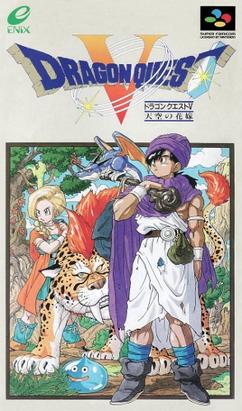
Dragon Quest V: Hand of the Heavenly Bride is a role-playing video game and the fifth installment in the Dragon Quest video game series, second of the Zenithian Trilogy. Originally developed by Chunsoft and published by Enix Corporation, Dragon Quest V was the first title in the series to be released for the Super Famicom video game console in Japan in September 1992. Dragon Quest V was the first game in the series to not be released in America due to programming issues at the time.
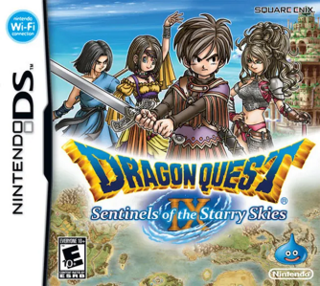
Dragon Quest IX: Sentinels of the Starry Skies is a role-playing video game co-developed by Level-5 and Square Enix for the Nintendo DS. Published by Square Enix in Japan in 2009, and by Nintendo overseas in 2010, it is the ninth mainline entry in the Dragon Quest series. The storyline follows the protagonist, a member of the angelic Celestrian race, after a disaster in their home scatters magical fruits across the mortal realm. While carrying over traditional gameplay from the rest of the series with turn-based battles, the game is the first Dragon Quest entry to feature a customizable player character, and the first to include a multiplayer mode, with the option of trading treasure maps and loaning player characters through Nintendo Wi-Fi. Online functions ended in 2014 when it ceased operations.

Dragon Quest Monsters, released in North America as Dragon Warrior Monsters, is the first video game in the Dragon Quest Monsters series. It was released in Japan by Enix on September 25, 1998, and co-published by Eidos Interactive in Europe and North America in 2000. It was the first Dragon Quest game to be released in Europe. The game cartridge is compatible with both the black-and-white Game Boy and the Game Boy Color; a second printing of the game was made after the Game Boy Color itself was released. The game was remade for the PlayStation in a compilation Dragon Quest Monsters 1+2 Hoshi Furi no Yūsha to Bokujō no Nakamatachi. A mobile phone incarnation titled Dragon Quest Monsters i was released in Japan on January 28, 2002.
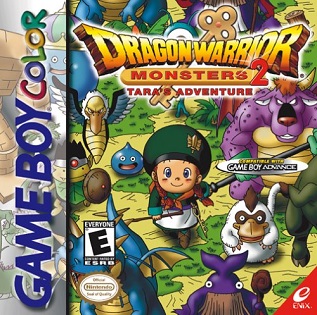
Dragon Warrior Monsters 2, known in Japan as Dragon Quest Monsters 2, is a role-playing video game published by Enix for the Game Boy Color. It is the second Dragon Warrior Monsters game for the Game Boy Color and features two different versions of the same game, Cobi's Journey and Tara's Adventure. Both games were remade in 2002 for the PlayStation in a compilation game called Dragon Quest Monsters 1+2 and released only in Japan. The Nintendo 3DS version combined both games into one and was released only in Japan in 2014 with the title Dragon Quest Monsters 2: Iru and Luca's Marvelous Mysterious Key. The 3DS version was later brought to iOS, Android on August 6, 2020, in Japan.

Dragon Quest: Monster Battle Road is a series of Japanese arcade games based on Dragon Quest VIII: Journey of the Cursed King. Players battle monsters and can win real-life cards with monster data imprinted on them. The first game, also titled Dragon Quest: Monster Battle Road, was released in 2007 only in Japan, using the Taito Type X2 system. A sequel, Dragon Quest: Monster Battle Road II Legends, was announced at the 2009 Jump Fiesta in Tokyo, and a third game in the series, Dragon Quest: Monster Battle Road Victory, a port of the Legends game, was announced for the Wii in 2010. Dragon Quest: Monster Battle Road Scanner was scheduled for release in the arcade in 2016.

Dragon Quest X: Rise of the Five Tribes Online, also known as Dragon Quest X Online, is a massively multiplayer online role-playing game (MMORPG) developed and published by Square Enix. It is the tenth mainline entry in the Dragon Quest series. It was originally released for the Wii in 2012, and was later ported to the Wii U, Windows, PlayStation 4, Nintendo Switch, Android, iOS, and Nintendo 3DS, all of which support cross-platform play. Other than a discontinued Windows version in China, the game was not released outside of Japan. A single-player remake, titled Dragon Quest X Offline, was released in 2022 in Japan. It is also set to release in other Asian regions in 2024.
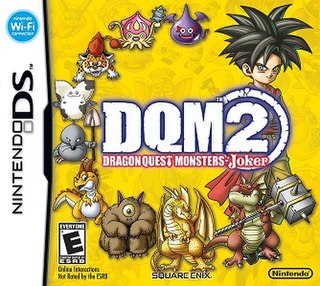
Dragon Quest Monsters: Joker 2 is a 2010 role-playing video game developed by Tose and published by Nintendo for the Nintendo DS. It is the sequel to Dragon Quest Monsters: Joker (2006) and is the fifth game in the Dragon Quest Monsters series. A sequel, Dragon Quest Monsters: Joker 3, was released in 2016.

Dragon Quest Heroes: The World Tree's Woe and the Blight Below is a hack and slash game developed by Omega Force and published by Square Enix. It was released for PlayStation 3 and PlayStation 4 in Japan in February 2015, and in North America, Australia and Europe only for PlayStation 4 in October 2015. It was later released for Microsoft Windows in December 2015. The game received generally positive reviews, with a sequel Dragon Quest Heroes II being released in Japan during May 2016. Dragon Quest Heroes would later be released with the sequel in a compilation for Nintendo Switch in Japan.
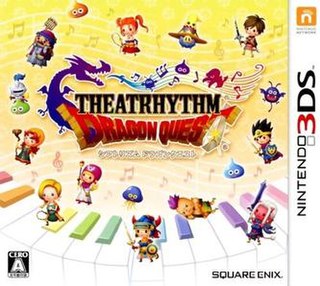
Theatrhythm Dragon Quest is a rhythm game developed by indieszero and published by Square Enix for the Nintendo 3DS. It was released in Japan on March 26, 2015, and was the first game of its type in the Dragon Quest series and the third Theatrhythm game after Theatrhythm Final Fantasy and Theatrhythm Final Fantasy: Curtain Call.

Dragon Quest Builders is a 2016 sandbox action role-playing game developed and published by Square Enix for the PlayStation 3, PlayStation 4, PlayStation Vita, Android iOS, and Microsoft Windows and published by Nintendo for Nintendo Switch.

Dragon Quest Monsters: Joker 3 is a 2016 role-playing video game developed by Tose and published by Square Enix for the Nintendo 3DS. It is the sequel to Dragon Quest Monsters: Joker 2 (2010), and is the sixth game in the Dragon Quest Monsters series.















